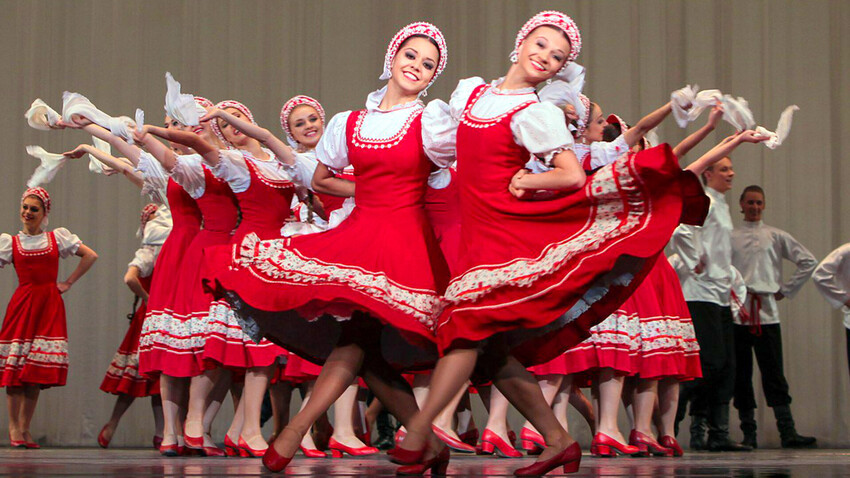
This song appeared in the early 20th century and it is believed that it was originally a gypsy dance song and was often performed at feasts. It was in the repertoire of several famous singers of the early 20th century.
Lidia Ruslanova's version and musical arrangement is now the most commonly known. The song became very popular at front line concerts during World War II and Ruslanova even sang it on the steps of the Reichstag after the Red Army had captured Berlin.
The original "folk" version of this song was sung by Moscow coach drivers who rode "with a bell" on a troika (sled) along ‘Piterskaya’ (i.e. the road from St. Petersburg to Moscow) and Tverskaya-Yamskaya Street.
The song became most popular when performed by Fyodor Chaliapin, a famous singer of the early 20th century. He combined several coach drivers songs and urban melodies.
This ‘khorovod’ (circle dance) chorus song is one of the oldest songs known today. Its melody was recorded and orchestrated by both Pyotr Tchaikovsky and Nikolai Rimsky-Korsakov. In the original version, it was sung by a sad girl who was married by force, who then went and broke off some birch branches to make a balalaika out of them.
It is believed that the song is connected with the Orthodox holiday of Trinity and the Russian custom, dating back to Slavic pagan times, to see off the spring, lead round dances and decorate houses with birch trees. There is also a popular folk-variety ‘birch’ round dance to accompany the song.
This ‘chastushka’ became very popular during the Russian Civil War. One of its "revolutionary" versions became the unofficial anthem of the red sailors.
The first musical notations of the song appeared in the early 20th century. Even more famous is not the song itself, but a dashing sailor's dance to it with squatting, throwing out legs and hopping from one foot to another, similar to a Cossack dance.
This folk song and its variations were sung by workers, barge haulers and other people engaged in hard labor. The song has been known since the 1860s, when it was first written. And, later, it became a revolutionary song of proletarians and one of the most popular tunes of the 1917 Bolshevik Revolution. It is most famously performed by Fyodor Chaliapin.
There were a huge number of verses in this soldier’s marching song, which could be invented on the fly. Some soldiers had to respond to others and the refrain to repeat was: "Soldatushki, bravy rebyatushki!" All the verses are connected with military valor. For example: “Soldiers, brave boys / Where are your children? / Our children are the cannons on the carriage / That's where our children are!”
This Cossack folk song is also known as ‘Stenka Razin's Dream’ and is considered a parable. The song is about a Cossack dreaming that he is prophesied to perish. It was first written down in the late 19th century and, later, in the middle of the 20th century, an orchestration was composed for it. Today, it is often performed by popular folk singer Pelageya.
This old Cossack romance song is sung on behalf of a dying Cossack: He asks a raven to fly to the Don River (to his native lands) and tell everyone about his impending death. There are several versions of the song and it is believed to be a folk reworking of a poem by Russian officer Nikolai Verevkin, published in 1831.
In many folk stories and tunes, such appeals to winter and frost with the request to save people are repeated in different ways. In the collection recorded by ethnographer Pavel Shein, there is a Tula song with the words: "Winter, my fierce winter! I beg you: don't freeze me!" In the old days, when embarking on a long journey in winter, Russian people were never sure whether they would reach their destination or whether they would succumb to the elements and freeze to death, so such chants were superstitiously supposed to ward off misfortune.
Many believe the most famous version of ‘Oh, frosty frost’ was recorded in 1956 by Maria Uvarova, a soloist of the Voronezh Russian Choir, together with her husband. She, later, tried for many years to prove her authorship, but never succeeded.
The song also gained huge popularity after it was performed by Valery Zolotukhin in the movie ‘The Master of Taiga’ (1968).
You are probably surprised that the most famous Russian “folk” song – ‘Kalinka-Malinka’ – is not on our list. Most researchers tend to believe that it was written in 1860 by the Saratov folklorist Ivan Larionov. And it gained worldwide fame after it was arranged by Soviet composer Alexander Alexandrov and performed by the Red Army Choir.
Still, there was a similar song that could have inspired Larionov – ‘Kalinushka s malinushkoi, lazorevy tset’ (‘Kalinushka with a little raspberry, azure color’), which was allegedly written in 1853. It isn’t as cheerful and extravagant, but more wistful. In it, a girl sings about her husband not coming home. It was often performed at the opera during the Soviet era.
Dear readers,
Our website and social media accounts are under threat of being restricted or banned, due to the current circumstances. So, to keep up with our latest content, simply do the following:
If using any of Russia Beyond's content, partly or in full, always provide an active hyperlink to the original material.
Subscribe
to our newsletter!
Get the week's best stories straight to your inbox